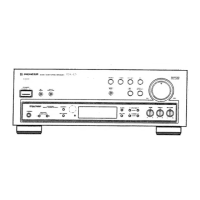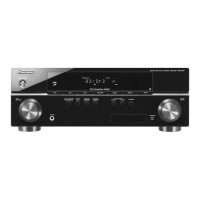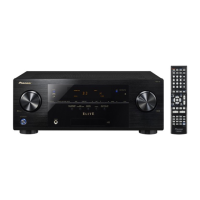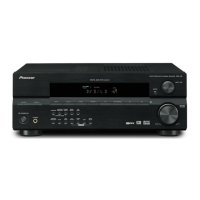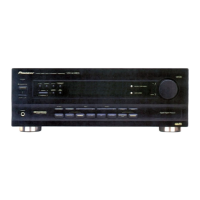Do you have a question about the Pioneer VSX-422-K and is the answer not in the manual?
Warnings regarding electric shock and product opening.
Precautions against water, fire hazards, and operating environment.
Ensure adequate space around the unit for proper heat radiation and airflow.
Information on collecting and disposing of old electrical equipment and batteries.
Verify all supplied accessories are included in the box.
Guidelines for safely placing and installing the AV receiver.
Connect and position speakers for optimal surround sound performance.
Connect external audio and video sources to the receiver.
Steps for automatic setup, basic playback, and sound adjustment.
Detailed description of buttons, dials, and indicators on the front panel.
Explanation of various status lights and displays on the receiver's front panel.
Overview of buttons and their functions on the remote control.
Instructions for inserting batteries into the remote control.
Factors affecting the remote control's performance and range.
Guidelines for optimal speaker positioning for the best sound experience.
How to connect front, center, surround, and subwoofer speakers.
Connecting additional speakers via pre-out terminals and an amplifier.
Important advice for making and managing cable connections.
Connecting components using HDMI for audio and video transmission.
Explanation of HDMI features supported by the receiver.
Connecting audio sources using RCA and digital audio cables.
Understanding how video signals are output from the receiver.
Connecting playback components and TV using HDMI, including ARC setup.
Diagrams for connecting devices lacking HDMI terminals.
Instructions for connecting AM and FM antennas for optimal reception.
Final steps to power up the receiver after all connections are made.
Configuring automatic power-off and front panel demo display.
Step-by-step guide to the automatic speaker calibration process.
Resolving issues and common problems encountered during Auto MCACC setup.
Instructions for selecting and playing sources like DVD or TV.
Choosing the correct audio input for each source component.
How to tune into radio stations and save them for quick access.
Customizing names for memorized radio stations.
Exploring Radio Data System features like program search and information display.
Choosing various modes for optimal playback of different audio sources.
Using automatic source detection and basic surround sound playback.
Exploring different surround sound effects for movies, music, and games.
Restoring compressed audio quality and applying acoustic calibration.
Improving sound reproduction by phase matching for clearer audio.
Configuring surround back channels and Up Mix for immersive sound.
Adjusting detailed audio parameters like EQ, delay, loudness, and HDMI audio routing.
Adjusting sound balance, stereo image, and center channel focus.
Adjusting height channel output and other specific audio settings.
Navigating the main menu for system configuration and settings.
Detailed setup for speaker size, crossover, levels, and distance.
Defining the frequency cutoff for bass distribution between speakers and subwoofer.
Balancing sound levels across all speakers for optimal audio output.
Specifying speaker distances for accurate sound delay and positioning.
Configuring the analog input terminal for different audio sources.
Configuring surround output connections and automatic power-off timer.
Managing front panel demo display and HDMI audio return channel settings.
Prerequisites and steps for enabling Audio Return Channel functionality.
Solutions for operational problems, power issues, and no sound/image.
Addressing issues like receiver switching off, ARC conflicts, and overheating.
Diagnosing and resolving problems related to HDMI connectivity.
Procedures for resetting the unit to factory defaults and cleaning the exterior.
Detailed technical data for the AV receiver's audio, video, tuner, and digital sections.
List of parts and accessories provided with the unit.
